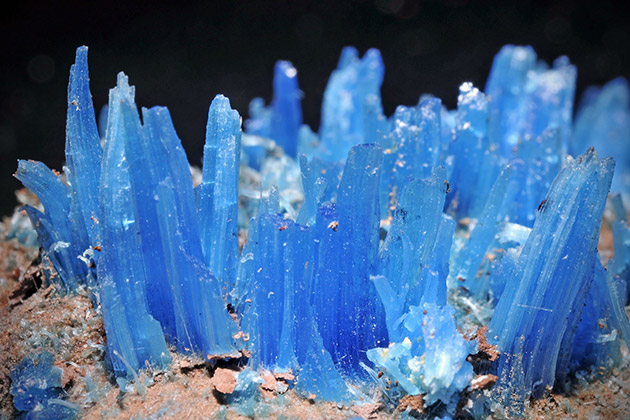
Galena is a natural mineral form of lead (II) sulfide. It is astonishingly beautiful… but not innocent at all.
This stone crystallizes in the cubic crystal system often showing octahedral forms, and often associated with the minerals sphalerite, calcite as well as fluorite. But if you are exposed to it for a prolonged period – either through simple contact or by inhalation of its dust – you risk suffering from the effects of lead poisoning.
5. Chalcanthite
Chalcanthite’s name comes from the Greek, chalkos and anthos, meaning a ‘copper flower’. It is a stunning blue/green water-soluble sulfate mineral CuSO4*5H2O. It’s commonly found in the late-stage oxidation zones of copper deposits. If its crystals are broken down in water, it can be deadly to the animals and plants which get in contact with the water.
4. Hutchinsonite
Hutchinsonite is a sulfosalt mineral of thallium, arsenic and lead with formula (Tl,Pb)2As5S9. It is a rare hydrothermal mineral. Plenty of it can be found throughout Europe. Hutchinsonite can cause hair loss, severe sickness or even death in people who come in contact with it.
3. Tobernite
Torbernite, whose name derives from the Swedish chemist Torbern Bergman (1735-1784), is a radioactive, hydrated green copper uranyl phosphate mineral. It is found in granites and other uranium-bearing deposits as a secondary mineral. Torbernite is not only radioactive but also the rocks containing it release deadly radon gas when heated.
2. Cinnabar
Cinnabar is a common bright scarlet to brick-red form of mercury(II) sulfide (formula HgS). It is the historic source for the brilliant red or scarlet pigment termed vermilion and associated red mercury pigments. When heated or damaged, the crystals release mercury, which causes anything from severe tremors to death.
1. Orpiment
Orpiment is a deep orange-yellow colored arsenic sulfide mineral with formula As2S3. It is found in volcanic fumaroles, low temperature hydrothermal veins, and hot springs.
Orpiment is formed both by sublimation and as a byproduct of the decay of another arsenic mineral, realgar. A touch is enough for it to release a neurotoxin. In some cultures, it is even used as a weapon – its dust is applied on arrowheads.
Via TechEBlog












